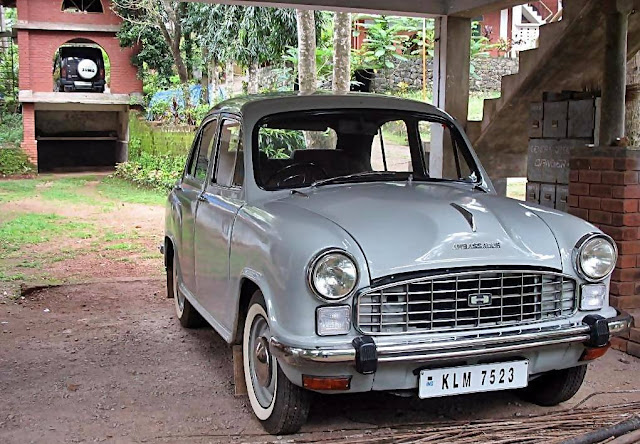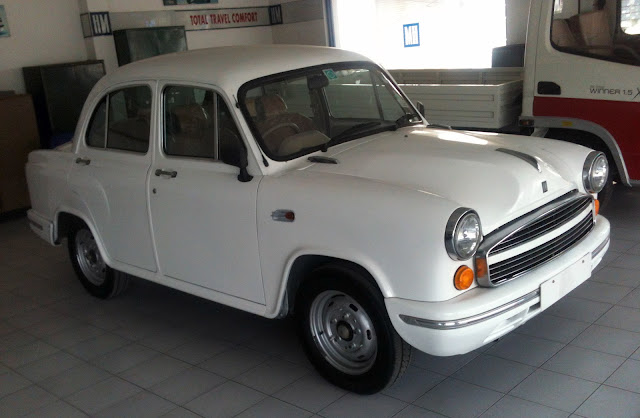Ambassador Mark-I (1st Generation)
In
1957, Hindustan Motors had entered into an agreement with British Motor Corporation to manufacture 1956 Morris Oxford
series III in India. All the tools and equipments were transferred to Uttarpara plant in
India. The car was renamed as Hindustan Motors Ambassador and was launched in
mid 1957 and the early model Hindustan Landmaster, which was derived from Morris Oxford series
II was discontinued. This new model included deep headlamp cowls and small rear
wing . The dashboard compartment and steering
wheel were completely redesigned. The flat-plane two-spoke steering
wheel of Landmaster was modified into a dished steering wheel with three spokes made-up of four
wires per spoke, for the Hindustan Motors Ambassador. It also got a new dimpled bonnet.
This model was powered by a 1476 cc side-valve petrol engine under hood developed by Austin Motors.
In 1959, a 1489 cc overhead-valve BMC B-series petrol engine with 55 bhp replaced the
side-valve engine.
Ambassador Mark-II (2nd Generation)
In January 1964, the Hindustan Motors Ambassador front was changed with a closely chequered grill. The interior had a redesigned dashboard with instrument cluster. The initial models had sun mica sheet but from 1968 models it was replaced by wood grain coated plywood and aluminium bezel. This model was named as Ambassador Mark II. The mid 60's model had minor changes to the tail section with integrated lens for indicator and danger lamps. A smaller chrome metal bumper stopper replaced the tall bumper stopper from the Mark-I. This model was sold till mid 1975 and then came the Mark-III model. In 1975 the Hindustan Motors Ambassador had no competition except the Premier Padmini.
In 1975 the Mark-III version was launched with another small change in front with horizontal louvres and a round profile indicator lamps separated from the grill giving it a modern feel . More modern looking number plate bezel has replaced the early design which was commonly used by many other British cars. The interior had a upgraded dashboard with 3 standard instruments mounted on a black recessed mesh. By 1978, the Standard and Deluxe versions were introduced. The Deluxe version had four meters plus the speedometer on dashboard. Just before the launch of the Mark 4, wiper configuration was changed to common direction sweep for both wipers. The Hindustan Motors Ambassador Mark-III was in production for only 3 years and was replaced with Mark-IV model in 1977.
Ambassador Mark-IV (4th generation)
In 1979 the Hindustan Motors Ambassador front got a major change which was
continued till its end in 2014. The grill height was reduced with a
larger chequered grill and square park lamps were added in place of indicator
lamps. Separate amber indicator lamps were embedded on the front spoiler
below the bumper. This model was labelled as the Mark 4. In addition to the
existing petrol version, a diesel variant was launched with a 1489 cc, BMC
B-series diesel engine which delivered 37 bhp of power. It was the first diesel
car in India and got a huge response from Indians. Mark 4 was the last car of the
Mark series. In 1990,
the Hindustan Motors Ambassador got major cosmetic changes mainly in the front styling and with minor changes to the dashboard. These changed were mainly
because of the protectionist policies followed by the Indian government at the
time.
Ambassador Nova (Fifth generation)
The Hindustan Motors Ambassador Nova was launched in 1990 in two variants, Deluxe version with 55
bhp powered petrol engine and Diesel DX version with 37 bhp powered diesel engine . Ambassador Nova had significant upgrades with modern steering wheel, new steering
column, better braking and electrical systems and a new radiator grille.
Ambassador 1800 ISZ
In 1992 another version was released and named as the Ambassador
1800 ISZ, in an attempt to increase its appeal. This new Hindustan Motors Ambassador model was powered by 1800
cc Isuzu inline-four engine which delivered 75 bhp of power. this is a slightly detuned engine that was used in Hindustan Motors luxury model HM Contessa 1.8 GL that produced a power of 88 bhp. It had a
five-speed manual gearbox, and also had the option of bucket seats, as opposed to
the earlier bench seats. The entire dashboard was redesigned. Instrumentation
panels were shifted from the centre of the dashboard to the right, behind the
steering wheel. Seat belts became standard. Since
1985, this 1817 cc/ 75 bhp (@ 5000 rpm), OHC, Isuzu engine, with 4 in-line cylinders and a max torque of 13.8 Kgm (@ 3000 rpm ) was provided for the special ordered VIP models with armour plating (Bulletproof). From early 1990s, this engine was available
as an option, in all the Ambassadors and this modern Japanese engine proved to be a success one lasted till the Hindustan Motors Ambassador entire production run.
Ambassador Grand
The Hindustan Motors Ambassador Grand was launched in 2003 with 137 new changes
compared to its earlier varients. The changes included body coloured bumpers, camel coloured interiors, fabric seats, remote shift gear
lever, moulded door trims and roof, salisbury axles, bigger rear wheel drums,
improved suspension system with anti roll bar, central door lock system, pre-installed music system and an optional sun roof. This Hindustan Motors Ambassador was available only in 2.0L and 1.8L engines. In 2007 the
1.5L model was added to the production line.
Ambassador Avigo
The Avigo model
launched in 2004 is the revision of the Hindustan Motors Ambassador, a part of a brand
revitalisation kicked off in the middle of 2003. The change of name indicated a different marketing strategy. Manvindra Singh has designed the exterior of this Ambassador Avigo. However,
the most intensive influence on the front bonnet has been that of the
original Landmaster series. At the rear tail lamp and name plate bezels were
redesigned and main panels remained as it is. Internally the Avigo, however, had much more classic-touch. The dashboard console was redesigned with a classic retro
theme resembling of the early models with central mounted meter new clusters
(like the Mark IV models). Seats were specially built with dual
tonne beige coloured scheme and with wood-grain interiors. A 6CD
Kenwood audio system and new air-conditioning system were installed. The car was
priced higher than the existing models.














No comments:
Post a Comment